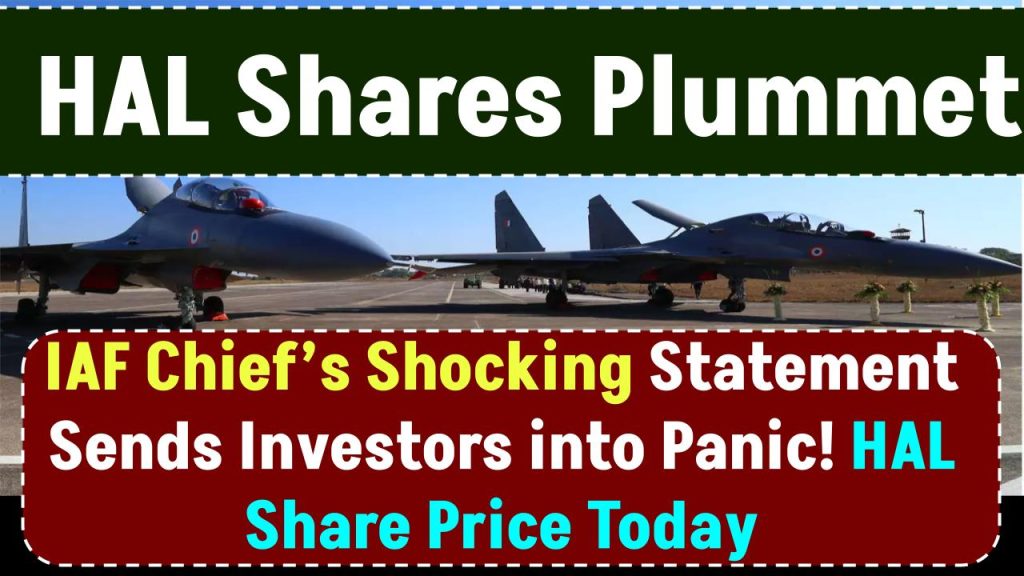
Hindustan Aeronautics Limited (HAL), one of India’s premier defense manufacturing giants, recently saw its stock price drop by over 2% following scathing remarks from the Indian Air Force (IAF) Chief, Air Chief Marshal A.P. Singh, about delays in the delivery of the Tejas Mk1A fighter jets. This development has triggered a wave of concerns among investors and the defense community, as it casts a shadow over HAL’s ability to meet its critical deadlines. In this article, we’ll explore what led to this sharp decline, how the situation is evolving, and what it means for investors and the future of HAL.
HAL Shares Plummet
| Key Takeaways | Details |
|---|---|
| Date of Stock Drop | February 12, 2025 |
| Stock Price | HAL shares fell 2% to ₹3,578.50 (down from ₹3,818.85) |
| IAF Chief’s Statement | Air Chief Marshal A.P. Singh expressed concerns over HAL’s delays in the Tejas Mk1A program. |
| HAL’s Response | HAL Chairman D.K. Sunil assured that technical issues were resolved, and deliveries would begin soon. |
| HAL Financial Performance | Despite recent declines, HAL has shown strong financial returns, with a 28.22% growth in the past year. |
| Investor Concerns | The key concern for investors lies in HAL’s ability to meet delivery schedules and maintain growth. |
| Official Website | HAL Official Website |
HAL’s recent stock drop highlights the ongoing challenges in the defense manufacturing sector, particularly when critical deadlines are missed. While the company has shown resilience in the past, the pressure to deliver on the Tejas Mk1A fighter jets has never been more urgent. Investors must stay informed about both the financial health of HAL and the company’s ability to meet its delivery commitments in the coming months. By monitoring these developments closely, you can make informed investment decisions in the defense sector, which remains a key pillar of India’s national security and economic growth.
Also Check: Reliance Share Price Crashes to 52-Week Low! drags Indian stock market for sixth straight session
HAL Shares Plummet Current Crisis: IAF Chief’s Remarks
At the prestigious Aero India 2025 event, Air Chief Marshal A.P. Singh made some startling remarks about HAL’s performance, particularly regarding the delivery timelines for the much-anticipated Tejas Mk1A fighter jets. The fighter aircraft are critical to the IAF’s modernization program, and delays could severely affect operational readiness.
In his address, ACM Singh expressed his dissatisfaction, stating, “At the moment, I am just not confident of HAL, which is a very, very wrong thing to happen.” He emphasized the importance of meeting delivery schedules and acting decisively rather than offering assurances. This public expression of frustration from the head of the IAF, an organization dependent on HAL’s products for national defense, has significantly impacted investor sentiment.
Investors have become increasingly wary of the company’s ability to deliver on time, which is one of the core drivers of HAL’s stock value. When a company is seen as unable to meet critical military contracts, especially in a defense-heavy economy like India, the results can be immediate and significant.
HAL Shares Plummet Response to the Crisis
In response to these concerns, HAL’s Chairman and Managing Director, D.K. Sunil, has stepped forward to assure both the IAF and the public that the company is addressing the issues that have caused the delays. According to Sunil, technical problems that had initially slowed production and delivery of the Tejas Mk1A have been resolved. He emphasized that deliveries would soon commence, aiming to restore the IAF’s confidence and prevent any further setbacks in the program.
While this is a positive sign, the challenge now lies in ensuring on-time deliveries and maintaining the high standards that the IAF expects. With national security at stake, any further delays could lead to broader consequences, not just for HAL, but for India’s defense capabilities.
HAL Shares Plummet Financial Performance: Strong Despite Setbacks
Despite the recent stock drop, HAL has demonstrated a solid financial track record. The company has enjoyed an impressive 28.22% return over the past year, highlighting its overall stability in an otherwise uncertain global defense market. HAL also maintains a healthy balance sheet with manageable debt, a key factor in weathering periods of uncertainty like the current one.
This resilience provides investors with some reassurance, although concerns remain about how the latest delays will affect the company’s ability to meet future commitments. The defense sector is notoriously cyclical and sensitive to government policies, and any shift in defense priorities could either stabilize or destabilize companies like HAL.
For investors, diversification is critical. Keeping track of the company’s financial health, as well as its ability to bounce back from this crisis, will be essential for anyone holding shares in HAL.
HAL Shares Plummet Bigger Picture: The IAF’s Growing Demands
The IAF has been grappling with a shortage of modern combat aircraft for years. As noted by the IAF Chief, the need for a robust fleet of fighter jets has never been more urgent. This urgency is compounded by increasing geopolitical tensions and the need for India to strengthen its defense capabilities.
HAL has been entrusted with the task of manufacturing indigenous fighter jets like the Tejas Mk1A, which is expected to replace the aging fleets of MiG-21s and MiG-27s. The delay in delivering these jets places additional strain on the IAF, forcing it to rely on imported aircraft while waiting for domestic production to ramp up.
To understand the scale of the problem, consider this: the IAF aims to have around 450 fighter jets by 2030. However, delivery delays could severely impact this target, affecting India’s defense preparedness.
HAL Shares Plummet Practical Advice for Investors
Investing in defense stocks like HAL can be highly rewarding, but also risky due to factors such as government contracts, delivery timelines, and international security dynamics. Here are a few key tips for those interested in HAL or other defense stocks:
1. Monitor Government Contracts
Defense companies are highly dependent on government orders. Keep a close eye on budget announcements and defense procurement policies. Any increase in defense spending is likely to benefit companies like HAL.
2. Understand Project Timelines
Stay informed about key projects and their delivery timelines. Delays, like those with the Tejas Mk1A, can significantly affect a company’s stock performance.
3. Diversify Your Portfolio
Don’t put all your eggs in one basket. Even with HAL’s solid financials, it’s crucial to diversify your investments to mitigate the risk of industry-specific issues.
4. Follow Industry News
Stay updated on global defense trends, as changes in international defense alliances and procurement programs can directly affect HAL’s stock price.
HAL Shares Plummet (FAQs)
What caused the HAL stock price drop?
The stock price drop was primarily due to concerns raised by the IAF Chief over delays in the delivery of Tejas Mk1A fighter jets. His comments have raised doubts about HAL’s ability to meet critical timelines.
Is HAL financially stable despite the decline in stock price?
Yes, HAL remains financially stable, with a 28.22% return over the past year and a healthy balance sheet. However, delays in meeting delivery schedules could affect future performance.
How can investors protect themselves from defense sector volatility?
Investors should diversify their portfolios, stay informed about government defense policies, and understand project timelines to minimize risks.
How does the Tejas Mk1A program impact India’s defense readiness?
The Tejas Mk1A program is critical for replacing aging fighter jets and improving India’s defense capabilities. Delays in this program could affect operational readiness.









